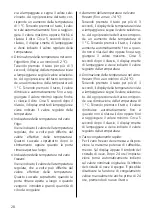
41
Defrosting
The refrigerator defrosts completely auto-
matically, thus melting any ice that has
built up on the back panel. This happens
approx. twice a day depending on how
often and for how long the door is ope-
ned. During the defrosting procedure the
temperature in the refrigerator rises so that
the ice on the back panel defrosts comple-
tely. After defrosting, the temperature
drops back to the original setting. The
water flows out through a drain hole
(Figure
4
) and evaporates in the collecting
tray outside the device.
Be sure to keep the collection channel and
the drainage channel clean, so that the
melted water can flow out easily. Clean
out the drainage channel with the green
cleaner provided using an up-and-down
and turning motion.
Defrost the freezer compartment if the ice
formation becomes excessive. A thick coa-
ting of ice reduces the effectiveness of the
cold transfer to the frozen products.
Keep the frozen products as cold as possi-
ble and well insulated during the defro-
sting time, e.g. pack them in newspaper.
– Turn off the appliance by using the main
switch (3 sec.)
– Pull out the water drain hole (Figure
5
)
– Place water catcher under the defrosted
water drainage channel (Figure
6
)
– Leave the doors open.
Defrosting can be accelerated significantly
if you place a bowl of hot water in the fre-
ezer compartment. Attention: do not use
sharp implements to remove ice or any-
thing hard frozen. Do not use an electrical
heater or an open flame for defrosting.
– After defrosting clean the interior and
dry it thoroughly.
– Turn on the appliance by using the main
switch (3 sec.)
3
4
5
6








































